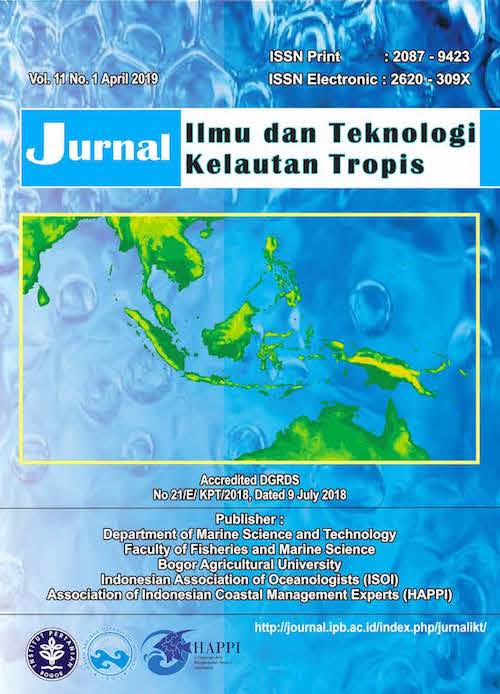SPATIAL DISTRIBUTIONS OF NUTRIENTS AND CHLOROPHYLL-A: A POSSIBLE OCCURRENCE OF PHOSPHORUS AS A EUTROPHICATION DETERMINANT OF THE JAKARTA BAY
Abstract
Phytoplankton blooms due to nutrient enrichment (eutrophication) have been considered as the primary factor causing several massive fish kills occurred in the Jakarta Bay. This study aims to determine the spatial variation of phytoplankton abundance based on chlorophyll-a concentration and its relationship with nutrient level and composition. A field observation was conducted in July 2015 measuring chlorophyll-a and nutrient concentrations. Chlorophyll-a was measured using fluorometer Trilogy AU-10 while nutrients was using spectrophotometer Shimadzu UV-1800. The result showed that chlorophyll-a concentration was relatively higher in the western compared to the eastern region of the Jakarta Bay. In addition, the western region was high in orthophosphate, nitrate and silicate while the eastern region was high in ammonium and nitrate. Statistical analysis shows that chlorophyll-a had the highest significant correlation against orthophosphate in the western region and chlorophyll-a had no significant correlation with nutrients in the eastern region. It seems that phosphorus was the primary determinant of chlorophyll-a variability with a concentration of orthophosphate of more than 0.028 mg P/L is required to increase chlorophyll-a concentration. In addition, low orthophosphate concentration (0.014 mg P/L) below its minimum requirement for maximum phytoplankton growth was likely the factor causing the absence of chlorophyll-a and nutrients relationship in the eastern region. In summary, phosphorus is seemingly the primary eutrophication determinant in the Jakarta Bay.
Full text article
Authors
This work is licensed under a Creative Commons Attribution 4.0 International License.
Jurnal Ilmu dan Teknologi Kelautan Tropis i is an open-access journal, meaning that all content is freely available without charge to the user or their institution. Users are allowed to read, download, copy, distribute, print, search, or link to the full texts of the articles in this journal without needing to request prior permission from the publisher or the author.
All articles published by Jurnal Ilmu dan Teknologi Kelautan Tropis are licensed under the Creative Commons Attribution 4.0 International License. This allows for unrestricted use, distribution, and reproduction in any medium, provided proper credit is given to the original authors.
Authors submitting manuscripts should understand and agree that the copyright of published manuscripts is retained by the authors. Copyright encompasses the exclusive rights of authors to reproduce, distribute, and sell any part of the journal articles in all forms and media. Reproduction of any part of this journal, its storage in databases, and its transmission by any form or media is allowed without written permission from Jurnal Ilmu dan Teknologi Kelautan Tropis.

